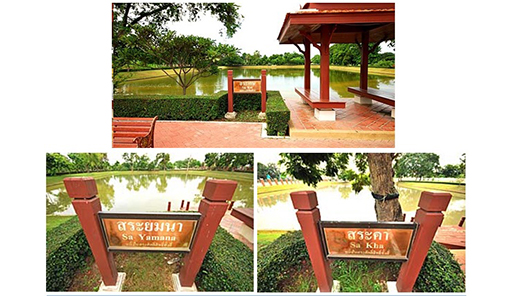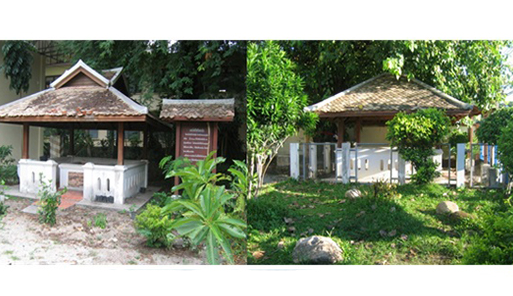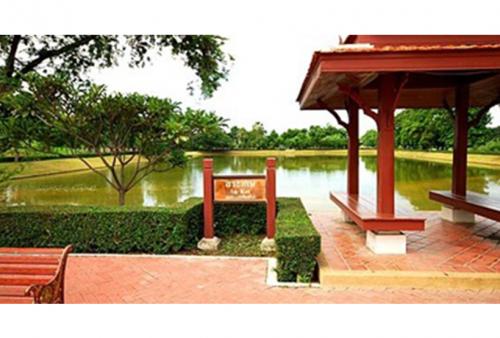Writer (Thai Version): Natikarn Chantayod *
Water is essential for all living beings. It is normally used for consumption and for cleansing. However, in some cultures, water is regarded as having ceremonial importance. In India, the country of Hindu faith, water is a part of various ceremonies, including Pratham Abhisheka—the first cleansing during the first hair removal ceremony of a baby, Rajyabhishek—a holy bath during the coronation ceremony, Sangha Abhishekam—a holy bath given before the king sets out for war, Acharya Abhishekam—a water ceremony to install a person as a teacher, and Prarabdha Abhisheka—a water ceremony to celebrate one in becoming a king.
The Origin of the Coronation Ceremony
The idea to enthrone a king in Suvarnabhumi country originated from India. According to this belief, a king must undergo several important ceremonies in order to ensure legitimacy and completeness of holding an office, including Abhishekam, oath taking ceremony, the ceremony of the enthronement. Among these, Abhishekam or Indra Abhishekam is the most important ceremony and one that concerns water. The use of water represents a symbolic cleansing for a person endowed with a new office or who enters a new stage of life, in order to bless him with a successful future. It is a bath for one to become a great man, namely a great king or a Rajadhi Raja.
Coronation ceremony varies slightly in different regions due to the difference in local customs. It is called differently in different regions. According to scholars, Thailand might not have inherited the holy coronation ceremony directly from India. Mon, Java, and Khmer culture are more likely to have been the origin. The ceremony is called Phra Ratcha Phiti Borom Racha Phisek(the Royal Coronation Ceremony). It is the most important ceremony held on the occasion that a new king is enthroned. Its purpose is to fully install the king as the sovereign of the kingdom.
The coronation ceremony in Thailand first appeared on the second stone inscription of Wat Sri Chum from Sukhothai Period, estimated to have dated back to 18th Buddhist Era. The inscription mentioned the enthronement of Pho Khun Bang Klang Hao: "...Pho Khun Pha Muang thus installed Pho Khun Bang Klang Hao upon the town of Sukhothai. [His Majesty] also gave the fellow king a royal name called Si Inthrathit...”
In Ayutthaya Period, an evidence of a coronation ceremony is found in the Testament of the People from the Old Capital. There was a mention of the procedures of the ceremony, i.e. "King Si Ayutthaya ordered that a fig tree was made into a royal seat for the king to take a royal bath during auspicious ceremonies, for example, the coronation ceremony. The king must be seated at the royal seat made of fig wood for a holy bath (before moving to be seated on the Phatarabit Royal Throne). Then, the ministers will present [the king] with the crown jewels.” Besides, the coronation according to the tradition of Ayutthaya court was revived in full during the reign of King Rama I in 1783 AD.
In Thonburi period, although no documents regarding the royal coronation has been found, there was other historical document that registered the time period in which the king was enthroned, namely the year 1768 AD. The document is an archive written by an astrologer of the court in the 8th part of the national chronicle, which says "The year of a rat, 1130 Thai Minor Era, the town of Phitsanulok, Phichit surrendered to the royal grace. The town of Sema has been won on the first waning moon day. At one hour in the morning, there was an earthquake. This year marks 34th year since Phra Chao Tak was enthroned.”
The coronation ceremony in Rattanakosin Era adhered to the tradition of Ayutthaya Period. According to the national chronicle, "When King Yodfa Chulaloke was enthroned following the requests of the ministers and the people in 1782 AD, the king firstly conducted a brief ceremony of enthronement. Then, the king commissioned an assembly of well-versed civil servants from the old capital, presided by Chao Phraya Phetch Phichai, and the patriarch along with high-ranking monks in order to research the courtly tradition of coronation. when the procedures of the ceremony had been studied, and when the city was at peace, the king commissioned a coronation ceremony to be held in full according to the ancient tradition in 1785 AD. This tradition was preserved in the following reigns. The coronation ceremony is composed of 4 procedures:
1. Preparation The water will be drawn and stored in order to be presented to the king as holy water and to be sprinkled over the head of the king. A golden plate inscribed with the royal name and the king’s fortune is prepared. The royal seal is made. The accessories and tools for the ceremony are prepared. The venue is set.
2. The Primary Ceremony is composed of a chanting ceremony conducted by monks over the holy water and holy threads. Auspicious candles are lit.
3. The Coronation Ceremony This stage consists of a sprinkling of holy water over the king’s head, the presentation of the holy water from eight directions which takes place at Atthathit Uthumphon Ratcha-ad Royal Throne, the enthronement ceremony and the presentation of the royal regalia, which takes place at the Phatarabit Royal Throne.
4. The Final Ceremony consists of a general audience held by the king, the installment of the queen, a vow taking ceremony to become the patron of Buddhism, a ceremony to pay homage to the relic of the previous kings and queens, a ceremony to take the royal bed, and a procession around the city.
The Sources for the Holy Water Used in Coronation Ceremony.
During the preparation of the ceremony, water must be drawn from several important sources in order to be used as holy water for the royal presentation and for sprinkling over the head of the king. Such water must be extraordinary. According to the Brahmin's Veda, the water for the king or those who are to take the reign must come from Panja Mahanati or five great rivers in India, namely the Ganga, the Yamuna, the Aciravati, the Sarabhu, and the Mahi. These rivers are believed to flow from Mount Krailas which, according to Hinduism, is a holy place and a place of residence of Lord Shiva.

Sa Ket pond, Sa Yomana pond, Sa Kha pond are three from four sources for the Holy Water
Used in Coronation Ceremony from Ayutthaya to Rattanakosin Period, which are currently located in Suphanburi.
From Sukhothai to Ayutthaya, although the coronation ceremony had been mentioned, there was no evidence suggesting that water from the great rivers of India had been used. It is very likely that long travel between Thailand and India made it impossible to carry the water for ceremonial use. This is because the king is required by the royal tradition to hold the coronation ceremony within seven days or at the latest around one month after having taken the throne. The ceremony is also to be held before the royal funeral of the late king. Therefore, it was impossible to carry the water from India in time. However, there was evidence of the use of holy water in the coronation ceremony in the stone inscription of Wat Si Chum to which King Lithai was a patron. The inscription mentioned the enthronement of Pho Khun Bang Klang Hao as the king of Sukhothai by Pho Khun Pha Muang (589 AD), "The water that springs from Lingaparvata on Wat Phu below the town of Champasak was used as the holy water.” In Ayutthaya period, according to evidence, the holy water used in the coronation ceremony were taken from Sa Ket pond, Sa Kaew pond, Sa Kha pond, Sa Yomana pond, which are located in Suphanburi.
Later in Rattanakosin Period, from the reign of King Yodfa Chulaloke or King Rama I to King Chom Klao or King Rama IV, apart from the water drawn from the same sources as in Ayutthaya Period, the coronation ceremony used the water that was taken from other five important rivers which were called Bencha Sutthi Khongkha. This amount of water includes:
1. Water from Phetchaburi river, drawn at Tha Chai subdistrict, Phetchaburi province.
2. Water from Ratchaburi river, drawn at Daowa Dungse subdistrict, Samut Songkram province.
3. Water from Chao Phraya river, drawn at Bang Kaew subdistrict, Angthong province.
4. Water from Pasak river, drawn at Tha Raab subdistrict, Saraburi province.
5. Water from Bang Pakong river, drawn at Phra Ajarn subdistrict, Nakhon Nayok province.

Phetchaburi river, drawn at Tha Chai subdistrict, Phetchaburi province.
A ceremony of sanctification was held at an important religious site of the city. The water would be carried to the capital only after such ceremony.
In the reign of King Rama IV, the king ordered that there be four monks conducting a chanting to sanctify the water to be used in the ceremony to sprinkle water over the head of the king. Thus, another kind of holy water has been added.
In the reign of King Chulachomklao or King Rama V, the king used the water from the rivers Bencha Sutthi Khongkha, and from the four ponds of Suphanburi in the His coronation ceremony in 1868 AD. Later in 1872 AD, the king travelled to India. His Majesty brought back to Siam the water from Panja Mahanati, the five great rivers, as ascribed in Brahmin’s Veda. Therefore, the sprinkle water that was used in the king’s second coronation ceremony in 1873 AD consisted of the water from Panja Mahanati, Bencha Sutthi Khongkha, as well as from the four ponds of Suphanburi.
In the coronation of King Mongkut or King Rama VI in 1910 AD, the sprinkle water was from the same source as the in previous reign. However, later upon the celebration of the coronation which took place in 1911 AD, apart from the from Benja Mahanati, Bencha Sutthi Khongkha, as well as the four ponds of Suphanburi, other sources of water and rivers in several regions were added as a source for the holy water. The water from these sources, which are regarded as significant and auspicious, were brought to undergo a ceremony of sanctification at seven Maha Chedis which are the landmarks to seven great ancient cities. These sources are:
1. Pasak river. The water wa Buddha Footprint site is believed to be the sacred site of the region, namely the location the city of Lawo and Ayutthaya.
2. Talay Kaew and Sa Kaew pond in Phitsanulok, and Sa Song Hong pond. The ceremony of sanctification was held at the hall of Phra Phutta Chinnarat Hall at Wat Phra Si Rattana Mahathat in Phitsanulok province, which is regarded as the sacred site of the northern provinces.
3. Kraphang Thong marsh, Kraphang Ngern marsh, Kraphang Changphuek marsh, Kraphang Phaisi Marsh, Choke Chompoo pond, Nam Bo Kaew Well, Nam Bo Thong well, which are located in the town of Sawankhalok. The ceremony of sanctification was held at the main hall of Wat Mahathat which has always been regarded as an important place of worship since King Phra Ruang in Sukhothai period. (It is now located in Sukhothai province.)
4. Nakhon Chaisi river at Bang Kaew district, dew drops from the Phra Pathom Chedi, Sa Phra Pathom Chedi pond, Sa Nam Chan pond. The ceremony of sanctification was held at Phra Pathom Chedi, an important religious site from Dvaravati period.
5. The wells at Wat Na Phra Lan temple, Wat Sema Chai temple, Wat Sema Muang Temple, Wat Pratu Khao temple, Huay Khao Mahachai stream, and Bo Pak Nakarat well. The ceremony of sanctification was held at Wat Mahathat temple, the sacred site of Nakhon Si Thammarat province.
6. Bo Thip Well of Nakhon Lamphun. The ceremony of sanctification was held at Wat Phra Mahathat Hariphunchai, an important place of worship of the Northern provinces, including Nakhon Hariphunchai, Nakhon Khelang, Nakhon Chiang Saen, Nakhon Chiang Rai, Nakhon Phayao, Nakhon Chiang Mai.
7. The well at Wat Phra That Phanom Temple. The ceremony of sanctification was held at Wat Phra That Phanom, Udon circle. The temple was the sacred site of the ancient city Kota Bun which is located in the Isaan region.
Besides, the water from these holy sources was taken for an sanctification ceremony at various important temples located in ten different Monthons which include:
1. Wat Borommathat Temple and Wat Thamma Mun, Chainat province, Monthon Nakhon Sawan.
2. Water from Sa Mahachai and Sa Hin Daad pond was enchanted at Wat Ya Sothon, Chachoengsao township, Monthon Prachinburi.
3. Water from Sa Kaew pond, Sa Khwan pond, Than Prasat Stream, Sa Pakthongchai pond was enchanted at Wat Narai Maharat Temple (formally named Wat Klang), Nakhon Ratchasima province, Monthon Nakhon Ratchasima.
4. Water from Tha Ho Chai pier, Kud Si Mungkhala lake, Kud Phra Ruechai lake was enchanted at Wat Si Thong, Ubon Ratchathani township, Monthon Isaan.
5. Water from Sa Kaew pond, Tharn Narai Stream was enchanted at Wat Plub Temple in Chanthaburi township, Monthon Chanthaburi.
6. Water taken from important sources in various districts of the province was brought for an enchanted ceremony which was held at Wat Phra That Temple, Chaiya township, Monthon Chumphon.
7. Water from Wang Plai Bua pond, Bo Thong well, Bo Chai well, Bo Ruesi well, and from Sa Kaew pond was brought for an sanctification ceremony held at Wat Taninara Samoson, Tani township, Monthon Pattani.
8. Water from Khao Toh Sae hill and Khao Tonsai hill was enchanted at Wat Phra Thong, Thalang township, Monthon Phuket.
9. Wat Mahathat, Phetchabun township, Monthon Phetchabun.
10. Wat Phra Mahathat,Phetchaburi township, Monthon Ratchaburi.
In sum, the holy water was made at 17 sites. It is still being used until now.

The wells at Wat Sema Chai temple and Wat Sema Muang Temple, Nakhon Si Thammarat province.
In the later period of King Pok Klao, King Rama VII, the sanctification ceremonies were held in 18 capital towns of all precincts. The sites of the ceremonies largely remained the same as in King Rama VI’s period. However, an amount of water was taken from Phra That Cho Hae in Phrae province instead of Wat Mahathat in Phetchabun province; and there was a new addition of a source, namely Phra Lan Chai in Roi Ed province.
In the period of King Bhumibol, King Rama IX, the holy water was taken from the 18 sources in various province as done in the period of King Rama VII. However, there was a change of using water from Bo Kaew pond and holding a ceremony of sanctification at Phra That Chae Haeng, an important religious site in Nan province, instead of Phra That Cho Hae in Phrae province.
After the holy water has undergone an sanctification ceremony at the Maha Chedis as well as Sacred Temples, the officers in charge will bring the water to the capital well ahead of the coronation ceremony. The holy water will be kept in the ubosot of Wat Phra Si Rattana Sadsadaram. When the day of the coronation ceremony arrives, the water will be brought in for further chanting ceremony in the Dusita Phirom Pavilion.
It can be said that water is an extremely important component of the royal coronation ceremony. Brahmin-Hindu belief worships Lord Shiva. Since Shiva resides on Mount Krailas, it is believed that water from this mountain is holy. The water is used in the coronation ceremony as it represents the complete hold of power as a sovereign. Although it is very difficult to obtain water from the five great rivers in India, there were attempts to find water from other important sources as alternatives. It has been found that, in Thailand, the holy water used in coronation ceremonies during Ayutthaya period was taken from four different ponds in Suphanburi. In early Rattanakosin period there was an addition of the holy water from five rivers, collectively called Bencha Sutthi Khongkha. It was only in King Rama V’s reign that the king brought the water from the great five rivers of India, Panja Mahanati, to be added to the existing holy water. Later in the reign of King Rama VI, water from various other sources was brought to undergo a holy ceremony at seven important Maha Chedis. From this, it can be said that the water came from every part of Thailand. Thus, the holy water for the ceremony might also bear a symbolic significance and imply the surrender of a sovereign power to the king and the central government.
*A curator at Bureau of Grand National Treasury, the Treasury Departement



